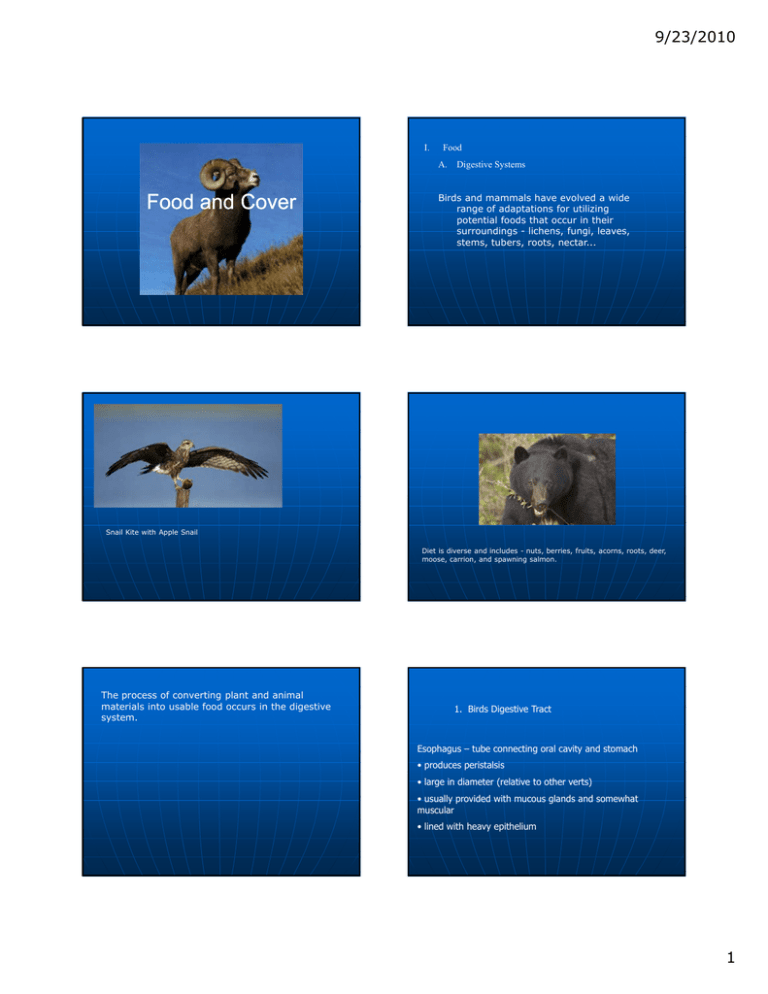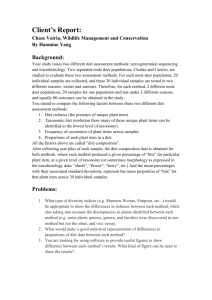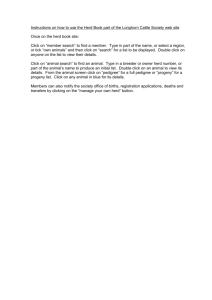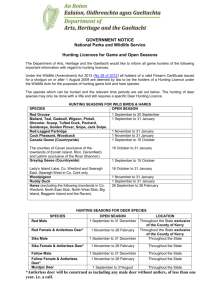Food and Cover 9/23/2010
advertisement

9/23/2010 I. Food A. Food and Cover Digestive Systems Birds and mammals have evolved a wide range of adaptations for utilizing potential foods that occur in their surroundings - lichens, fungi, leaves, stems, tubers, roots, nectar... Snail Kite with Apple Snail Diet is diverse and includes - nuts, berries, fruits, acorns, roots, deer, moose, carrion, and spawning salmon. The process of converting plant and animal materials into usable food occurs in the digestive system. 1. Birds Digestive Tract Esophagus – tube connecting oral cavity and stomach • produces peristalsis • large in diameter (relative to other verts) • usually provided with mucous glands and somewhat muscular • lined with heavy epithelium 1 9/23/2010 • Storage Seed-eating finches - side of esophagus has paired out - pockets for storage (swallowed or g g for nestlings) g ) regurgitated Geese pack full of food Large structure for food storage – Crop Food can be stored ~ 1 day+ • Shapes Variable in shape across taxonomic groups If amylase in saliva some digestion occurs in crop Fusiform – Trochlidae, Emberizidae Bilobed – Columbiformes Single Sac – Falconiformes, House Sparrows • Pigeons and Doves – Crop Milk • Grinding Function Hoatzin – crop serves as grinding organ Mourning Dove – • proliferation of lining begins after 8 days incubation Muscular, numerous glands, contains bacteria • sloughing 14 – 18 days • continues to 16 days after hatching 2 9/23/2010 • Other Functions Greater Prairie Chicken – anterior end modified as resonating chamber Flamingoes and male Emperor Penguins Oily esophageal secretion Air forced into sac from trachea via pharynx 59% protein 28% lipid Stomach Birds possess two kinds of stomachs: Anterior glandular stomach Posterior muscular stomach Proventriculus Ventriculus Strong muscular organ (granivores) Spindle-shaped glandular stomach – avian innovation Prepares food for digestion (analog of teeth) Not found in reptiles Size related to bulk of food intake Mucous glands present in walls – secrete koilin lining Large – piscivores, frugivores, granivores 3 9/23/2010 Functions as principle barrier to indigestible material • In granivores may contain grit • feathers • lined with tough, abrasive, keratin layer (koilin) – cutica gastrica • hair • bone • teeth avian gastrointestinal tract - distinct reverse peristaltic movements (Duke 1994). allows material in the gizzard to reenter the proventriculus for additional treatment with acid and pepsin. Seasonal change in in structure of stomachs corresponding to seasonal change in diet Bearded Tits Winter diet – seeds, stomach 0.88 – 1.2g Summer diet – insects, stomach 0.5 – 0.6g Small Intestine • duodenal loop • ilium Chief organ of digestion and absorption Once food enters intestine undergoes complete chemical ateration via enzymes Small intestine generally g y shorter than mammals Contents mixed and absorbed by intestinal mucosa 4 9/23/2010 Function Receives – bile ducts, pancreatic ducts and secretions from glands in mucosa 3. Length variable – varies with diet, Long and tightly coiled– granivores, omnivores 1. Enzymatic activity – carbohydrases, lipases, proteases, and nucleases 2. Primary site of absorption – by time product reaches large intestine it is completely absorbed 4. Retention time related to diet Long – granivores Short – carnivores, frugivores Short and slightly coiled – raptors, insectivores frugivores Large Intestine Primary function is for water & electrolyte reabsorption No relation between diet and structure Relatively short organ Contains minimum amount of non-digestable waste quicklyy as possible p • wastes voided as q • wastes sometimes voided in other ways (e.g. pellets) 5 9/23/2010 Intestinal Caeca Posterior end of intestine occur pair of caeca Size variable Large – Folivores (Cranes, ducks, geese) Small – Falcons, woodpeckers, insectivores, passerines, piscivores Absent - Parrots Functions: 1. Absorption of water 2. Absorption b off non-protein nitrogen 3. Digestion of carbohydrates and proteins 4. Microbial breakdown of cellulose 5. Microbial synthesis of vitamins(?) I. Food A. Digestive Systems Vampire Bats – simple straight stomach, expandable for digesting and storing. 2. Mammals Herbivores – combination of complex stomachs, long ceca and long intestines. Similar to birds in that length of tract corresponds with diet Hindgut fermenters Foregut fermenters 6 9/23/2010 Ruminants Forestomach divided • 3 chambers store and process food • 1 chamber h b with ith digestion di ti Rumen – fermented and regurgitated Microbial fermentation provides 60-70% of the energy requirements for ruminants Cud chewed Reticulum – fermented Omasum & Abomasum B. Energy Herbivorous mammals experience a period of adjustment when changing diets. 1. Carbohydrates Includes cellulose, starch and sugars Cellulose contain a great deal of energy but only a few species can take advantage of it. 2 Fats 2. F Contain more than 2x per unit wght as do carbohydrates but digestive system extracts at slower rate. Grazing animals not adapted for fat utilization. Deer lack gall bladder and secrete bile into small intestine in small amounts 7 9/23/2010 3. Proteins Energy content equivalent to that found in carbohydrates. Because protein scarce, the abundance of protein in vegetation good measure of food quality. Not abundant in vegetation but concentrated at tips of growing stems, some seeds. 4. Vitamins Legumes (alfalfa, clover, beans and peas) fix N and thus good source of protein. Function as enzymes. In some locations vitamins naturally deficient. Lagomorphs conserve vitamins produced by bacteria in digestive tract by coprophagy. II. Ecology and Evolution of Feeding Behavior and Defense Similar to hindgut fermentation, little time for absorption in large intestine once cellulose is broken down by bacteria in the caecum Feeding relationship represents ongoing struggle predator prey Produce two types of feces, wet and dry. Dry – intestinal not ingested Wet – cecum, ingested Plants have evolved mechanisms for resisting herbivory and herbivores evolved means for coping with plant defenses. Denied – vitamin K deficiency Smith, C. 1970. Ecol Monographs 40:349-371 Coevolution – the joint evolution of two or more organisms with close ecological relationships, but lack any exchange of genes. Douglas Squirrels and pine trees in Northwestern US. Conifer seeds main food items Squirrels can remove all pine cones from single tree 8 9/23/2010 T resd u cesq u irelfectivensan d eh an cesurvialb y Squirrels evolved behaviors to deal with defense mechanisms • produce cones difficult to open • cones with fewer seeds • increase thickness of seed coat • careful selection of cones to avoid those with few seeds • stockpiling cones for low production years • produce less nutritious seeds • drop seeds early in year before young squirrels begin to feed • periodically producing almost no cones A. Food Quality For herbivores nature and availability of plant materials varies from place to place, season to season, as well as structure of plant. 1. Importance of soil fertility Herbivores select parts of plants (time and space) which they can extract energy and nutrients. Diets of carnivores varies little in quality. Food deficiency of carnivores typically problems of quantity rather than quality. Missouri – size and bone strength of adult cottontails varies according to soil fertility. Nutritional quality of vegetation depends on fertility of soil Michigan – sandy soils 2x increase in population (spring – fall) fertile soils 5x increase. Agricultural production preempted richest soils and wildlife forced into less than optimal habitat. Cottontails in Alabama (Hill 1972) 9 9/23/2010 3. Effects on reproduction 2. Effects of nutrition on body condition Antler development and body size greatly influenced by nutrition in White-tails. Verme (1965) studied fawn production of white-tails on different experimental diets. High Low 27 0 22 2 47 21 Fawns/doe 1.74 0.95 Male fawns 16 13 Female fawns 29 6 35.6 68.4 Yearling bucks on good diet --- 6-8 points Poor diet --- small unbranched, spikes # Does Does not g breeding Fawns produced % Males Differences of reproductive success of female white-tailed deer on good and poor ranges in New York State (Cheatum and Severinghaus 1950). Spruce Grouse select most nutritious needles. Selected needles sig higher protein, and mineral content than non-selected needles. Sensory mechanism unknown. 4. Selective feeding May partially compensate for scarcity of some nutrients. Bison and grazing lawns Ruffed Grouse often select flower buds from aspen that appear less vigorous. 10 9/23/2010 5. Effects on milk production Young animals require more protein than adults. Fawns born to does that have struggled through difficult winter more likely to die – carryover effect. Carnivores often supplement milk with regurgitated food. Herbivores rely solely on milk Whi White-tailed il d deer d - quality li off milk ilk doesn’t d ’ change h but b quantity i does. d 6. Protein requirement in birds Almost all young birds require diet rich in protein. Oilbirds only nocturnal fruit eating birds. Young fed protein rich nuts. Young fed primarily animal material even if adults consume different foods. Exceptions – young geese eat newly sprouted grass Mallard ducklings feed almost exclusively on insects and other arthropods --but by 2 months old vegetarian. 7. Sex-specific differences in diet Other studies consistently show that bucks dominate does when competing for winter food. Results bucks enter spring in better condition. Female White-tailed deer wintering on good range in Michigan consumed more grass and less browse than males. Feces contained larger quantities of nitrogen than did bucks. Female Pintails switch from diet of seeds and other plant material to one of insects during nesting season. 11 9/23/2010 B. Quantity of food Aldo Leopold documented 100+ cases where herds of Mule and/or White-tailed Deer populations increased to such #s that food supply threatened How can animal consume more food than is available in given habitat? ½ of cases disaster averted when hunting pressure increased to reduce herd size or made habitat improvements. Other cases overbrowsing resulted in mass starvation Healthy understory Problem – woody plants grow seasonally – new twigs in spring and summer. If too much consumed plants can’t regenerate additional twigs. Understory and ground cover impacted by deer 12 9/23/2010 Some species more severely affected than others – White Cedar regeneration is impaired when as little as 20% of new growth is removed. Elk overpopulation drastically altering regeneration of Aspen stands. Consume Aspen seedlings and suckers. The ultimate result is starvation and low birth rates. White-tailed deer affecting eastern deciduous forest communities. Agriculture exacerbating problem. Poorwills may hibernate for as long as 88 days. 1. Response to food shortages a. Birds Some spp. can live without food for extended periods. Hummingbirds, swifts etc. survive by entering torpor for few hours to several days. 13 9/23/2010 Other birds can still withstand temporary food shortages. Both Wild Turkey and Pheasants can survive 1-2 weeks of severe winter weather without food. Wild Mallards kept alive 3wks without food but lost 43% of body wght. When returned to normal diet regained mass in 28 days. b. Mammals Hibernation – specialized adaptive, seasonal reduction in metabolism concurrent with environmental pressures of lack of food and low temperatures. c. Case studies Length of hibernation period varies among mammals. i. Beaver-Basin Deer Herd Ground squirrel – few degrees above freezing Mammals that are not true hibernators can also lower body temps and metabolic rates for energy savings. Blackk Bears Bl B – Tb falls f ll only l ~ 7° below b l normall (saves ( 600Kcal / day). 1959 hunting resort on 5km2 coniferous lowlands on shore of Lake Superior Managers at resort nourished deer with commercial food each winter. White-tailed deer in northern areas – lower metabolic rates, movement reduced. Numbers increased but hunting and other sources of mortality inadequate at keeping herd in check. Early 1970’s more than 80 tons of feed each winter • Park Service policy prohibited feeding programs • Manager treated as resource management issue • Reduced feeding to 20 tons for each of next 2 winters. 1974 – land donated to National Park Service 14 9/23/2010 Data indicated that no reduction in Deer herd was occurring. • Local sportsmen critical of herd reduction policy. • Rumors began -> reduced credibility of Agency Herd size = 600 Carrying Capacity = 150 1976 – NPS proposed special hunt The plan • thirty-five hunters access to the area for a threeday period (1 deer/hunter) Public outcry – Press made hunt sound like turkey shoot State legislature passed resolution directing DNR to devise alternative proposal. • At the end of the three days another thirty-five hunters would be granted special permission to hunt. • Hunt to run from mid-January to the first day of March, or until three hundred deer were taken. Local hunting club challenged proposal, claimed hunt would decimate herd. Injunction postponed hunt and club started feeding herd illegally ($27,000). NPS started issuing citations for illegal feeding. Winter of ’76 – chaos 1983 herd reduced to 0 1977-1978 – herd neither fed nor culled, starvation reduced herd to ~100 animals. Snowmobilers, sight-seers 15 9/23/2010 1996 – biologists returned to see if deer had recolonized, hadn’t and White Cedar and maples still showed the effects of severe overgrazing from 20yrs. before. ii. Kaibab Plateau Herd Mule Deer herd from Kaibab forest north of Grand Canyon. Wildlife management didn’t fail Failure occurred because local residents and a judge didn’t have adequate knowledge of consequences to their actions. Herd benefited from predator control and protection from hunting during 1900 – 1920’s. 1905 – 4000 1924 – 100,000 Habitat obviously couldn’t support herd 60% of population died in 2 winters 1940 – 10,000 10 000 iii. Giant Panda Bamboo – synchronous reproduction Depletion of food resources (bamboo) in China Flowering cycle 40-120 years Daily consume ~ 18Kg of leaves and stems Historically Pandas switched to different species when die-off occurred. Not efficient – 17% of food consumed digested 2/3 day d spent eating. i 16 9/23/2010 Agricultural practices reduced diversity of remaining habitats. Critical food shortages faced with dieoffs. 2. Physical condition and Nutrition Assume large reserves of body fat are useful indicators of good condition and survival. Hepp et al. 1986 JWM 50:177-183 Related hunting mortality with mallard body mass 1970’ss – 138 died starvation 1970 Currently – wild population (mass/wing length) = Condition Index ~ 1000 - 3000 Current management – replanting, establishing new refuges. MeasureofNutrionalConditon Banded 5600 mallards along Mississippi river. – “state of body components controlled by nutrition and which, in turn, influence an animal’s fitness” 234 – recovered by hunters, had sig. lower Condition Index than those not recovered. • whole body fat – primarily used in small mammals, birds • skeletal k l l measurements andd weights i h ConcludedBirds in poor condition may be driven to habitats more susceptible to hunting pressure. • kidney fat index – ratio of fat mass/kidney mass x 100 (ungulates and lagomorphs) • urine characteristics (snow urine) – assess metabolites present (wolves and Cervids). • blood serum analyses • marrow fat – fat level in bone marrow, bone marrow fat believed to be last fat source depleted in starving animals. 17 9/23/2010 4 components of blood serum: 1. Urea Nitrogen - used as an indication of protein intake and energy deficiency, can be affected by the ability of a ruminant to recycle urea. 2. Creatinine - a non-protein nitrogen compound that is produced with the catabolism of muscle tissue. Increases can be associated with muscle necrosis, atrophy and starvation. 3. Total Protein - provides reference for protein intake, liver function, and immunological status. 4. Free fatty acids - produced in response to breakdown of fat tissue and is usually inversely related to the amount of energy in the diet III. Food Management A. Food Habit Determination 2 step process 3 broad categories Determine what organism eats • observational • feeding site surveys • post ingestion surveys post-ingestion Manage for that food resource 1. Observational – 2. Feeding Site/Browse Survey Direct observation widely used for large herbivores. Earliest approaches developed for use on domestic livestock Quantified as - bite counts (number of bites for particular plant) Attempt to measure amount of vegetation removed by foraging animals from area during given time period. - feeding minutes (time spent foraging on particular species) P id only Provides l generall dietary di t information. i f ti 18 9/23/2010 3. Post-ingestion Survey Typically determined by examining digestive tracts or products Simplest analysis is list of foods eaten don’t distinguish between •stomachs, crops •pellets •scats • foods eaten rarely with those that make up majority of diet • items of high nutritional content • items of high availability Amount of detail should be tied to management objectives B. Food Propagation ManagementGuid elns Some situations may need to aggressively manage a habitat in order to provide the required food. 1. Limit plantings to those species that are adapted to local climates, soils and moisture (natives are always preferred). e.g. oak plantings, food plots 2. Coordinate with other land-use activities (forest cuttings, controlled burns etc) 3. Share cropping can be cost effective. 4. Size is Important – plots less than 2 ha of unharvested grain not effective for increasing populations. How effective are food plots? C. Difficulties in Food Management 2. Erroneous Conclusions 1. Seasonal changes in diet Typically food readily available in fall during hunting season Many dietary studies conducted on hunter-killed specimens – introduces significant bias. Can lead to erroneous conclusion that food not limiting for population. 19 9/23/2010 Ruffed Grouse Spring, summer and fall reveal varied diet (clover, strawberry, grasses, hawthorn fruits, chokecherry, apple, insects) Found only 15min of feeding can extract enough energy to last 24 hours. Thus availability of male aspen buds is primary factor in their survival. Winter – only male, aspen buds Then there is “BIOFILM” Are animals eating a random sample of what is available Variability in rates of digestion 3. Lessons from Beaver Basin May seem most humane solution to starvation is food supplements. Artificial feeding presents serious drawbacks. Or S i Serious economic i andd ecological l i l problems bl develop. d l Are they selecting specific items? • Availability of White Cedar 151 kg per ha – 6 kg per ha Damage has lasted for decades (seldom considered) 20 9/23/2010 • Supplemental feeding disrupts digestive physiologies of starving animals. Sudden shift in diet can result in death. • Philosophical questions – how much should wild populations depend on humans. Not easy to manage for food requirements of organism Need to know • nutritional requirements • Feeding can result in undesirable characteristics. • rate of production • dietary di t requirements i t • population size Population data hard to determine Managers most often measure condition of vegetation as barometer of wildlife populations. Forage availability and consumption measured for Utah – Big Game Forage Condition Report If population is too large for habitat following course of actions can be taken 1. Do nothing g - starvation,, long-term g damage g to vegetation, g , Disadvantage public image damaged http://www.wildlife.utah.gov/hunting/ 2. Reduce the population by increased hunting, introduction of predators. 3. Live-trapping, Removal and Relocation Restores habitat to more natural system Disadvantage – high cost, where to relocate, survival rates, shortterm only. Gains public approval. Disadvantages Liberalized hunting regulations – outcries from public also when females are added to take. Introduction of predators – outcry from public (ranchers) 21 9/23/2010 4. Artificial Feeding Broad public appeal Disadvantage – encourages further population expansion, justified where food shortage is temporary 5. Habitat modification This option increases production of natural foods, setting back succession or by planting self-perpetuating vegetation. Disadvantage - Slow response time and lack of public enthusiasm, Advantage – cost effective, permanent IV. Cover A. Plant ecology - % of ground concealed by overlying vegetation Defined Can be important - 2 reasons 1. It can be important to protect organism from extremes in climate and thus wasteage of energy for thermoregulation Our definition - any physical or biological features that provide shelter from weather or concealment from predators 2. Protection from predators “Good Pheasant cover” B. Cover as Shelter Homeotherms use cover to prevent heat loss or build-up 22 9/23/2010 1. Vegetative Cover • White-tailed Deer seek conifers for cover – migrating 50km from summer range. • Given choice between food and cover – choose cover 2. Huddling Birds and mammals find shelter with others • Deer metabolism changes during winter Best winter cover = Closed conifer canopy Intercepts snow, reduces windchill • Walk 50 – 100km to permanent ice shelf to established rookery • Female lays single egg, incubated by male • Female returns to sea to fo age forage • Male incubates for 60 days (high winds & temps – 30 –40 F) • Male wght drops from 36.5 kg -> 20 kg • Walking 1.5kg How might a reduction in population size affect Emperor Penguins? • exposure to cold could cost 25kg (fatal) • since they huddle save ½ energy And thus lose only 15 kg 23 9/23/2010 C. Cover as concealment 1. Examples Value of cover as hiding place more often studied than as shelter from weather a. Snowshoe Hares Wolfe et al. 1982. Snowshoe hare cover relationships in northern Utah. Journal of Wildlife Management 46:662-670. Found a strong relationship between horizontal density of cover (up to 2.5 m) and abundance of snowshoe hare droppings. Favorite prey of medium – large carnivores • Hares chose cover with at least 40% density in 1st 1.5m above the snow level. b. Ruffed Grouse Cover requirements well – known • This found in subalpine fir, spruce, Aspen/conifer edges. Dense undergrowth in regenerating Aspen stands – ideal protection! • Not found in Douglas Fir, stands of pure Aspen • Low undergrowth is sparse – see approaching predators • Thickets of aspen stems usually restrict movement of mammalian predators 24 9/23/2010 Other plants such as alder can provide similar protection but… As aspen stands mature they become less dense and progressively poorer cover Good Grouse Cover should include 3 age classes within a few hundred meters • Youngest age class – too immature to provide cover • Middle age class – (8-20 years) good cover • Older age class – (20-40 years) produces winter food Tall conifers should be discouraged because they provide perch sites for hawks and owls Overall – aspen does not hide grouse from predators but rather helps them see predators and impede their access c. Ring-necked Pheasants Cultivated plants important component for pheasant cover (cereal grains, hayfields etc) WI – no pheasants in Co. < 20% cultivation Increased 55-70% Declined > 70% South Dakota – IL Radio tracking data for hens and broods 1940’s crops rotated, ~ 80% brood survival Available cover = corn, small grain, residual cover, pasture, summer fallow, alfalfa (<5%), shelterbelts,, and ditches 1970’s 50% brood survival Utilized cover = Alfalfa (13%), ditches, small grain fields 25 9/23/2010 Yg require diet high in Row crops problematic Protein -Weed free Satisfy this requirement if they can feed on insects 3mm or larger -Few insects Found – oats, sweet clover, small grains Afte WW II production After p od ction of row o crops c ops expanded e panded CRP has helped! Conservation Reserve Program Pays landowners to allow acres to lay fallow and replanted with grasses etc. Potential problem p oblem on the horizon??? ho i on??? 26







